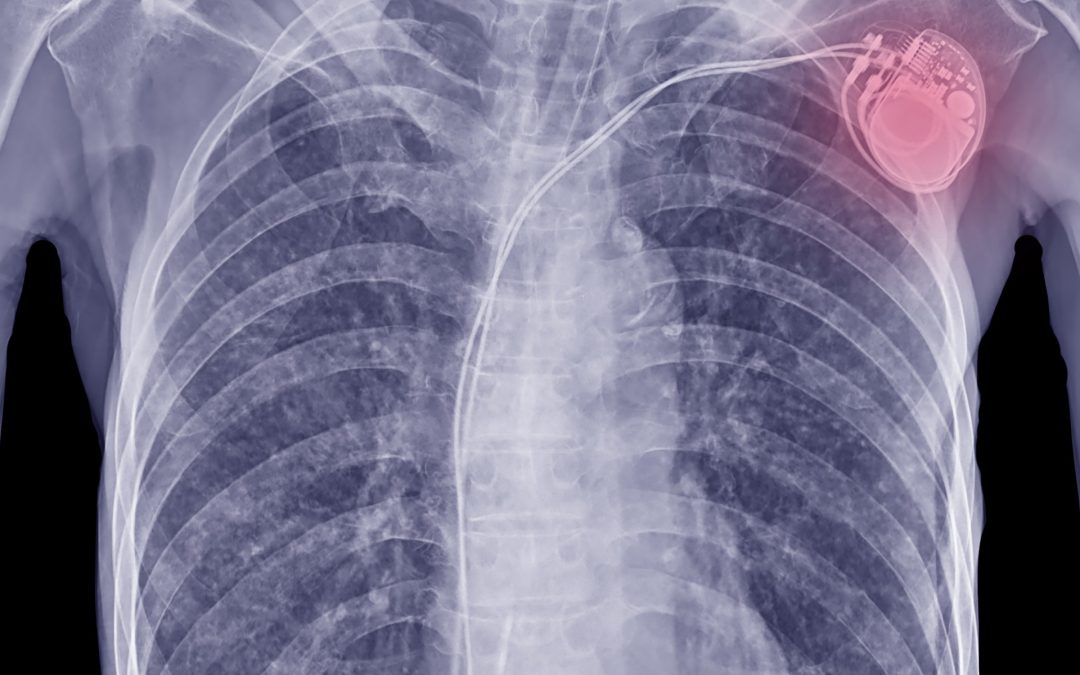Our webinar and accompanying blog post from June 2024 covered EMFs and implantable medical devices. The blog post outlined several organizations around the world that have set exposure standards or guidelines. This blog post will expand on that information and provide some numbers and comparisons for EHS professionals interested in occupational exposure limits for pacemaker wearers. The content of this post is technical and not aimed at a general audience. If you are interested in EMF found in homes and typical offices, you can refer to this booklet: Understanding Electric and Magnetic Fields, published by BC Hydro.
Guidelines on Occupational Exposure to EMF
Three types of EMFs that have regional and international exposure guidelines are static fields (0 Hz), power frequency fields (50–60 Hz), and radio frequency fields (~3 kHz–300 GHz, or approximately between 3 thousand hertz and 300 billion hertz). In Canada, exposure to radio frequency EMF is informed by Safety Code 6. There are no federal guidelines on exposure to static and power frequency fields, but some local authorities have created guidelines and limits, and Health Canada recommends following the guidelines published by the International Commission on Non-Ionizing Radiation Protection (“ICNIRP”) (static magnetic fields, low frequency fields, radiofrequency fields). Other guidelines relevant to the North American context are the American Conference of Governmental and Industrial Hygienists (“ACGIH”) (2023 TLVs and BEIs), and the Institute of Electrical and Electronics Engineers (“IEEE”) (IEEE Std C95.1-2019). There are also further guidelines found internationally such as in the European Union, Australia, and various countries and organizations on other continents. This article will examine the existing guidelines for each of these three types of EMFs with reference to Safety Code 6, ICNIRP, ACGIH, and IEEE.
Typical occupational sources of EMF are presented in Table 1 copied from Electromagnetic fields in working life. A guide to risk assessment published by the European Trade Union Institute. Table 1 breaks down EMF sources into four frequency ranges: static field (0 Hz), LF field (low frequency: 0 Hz–20 kHz), IF field (intermediate frequency: 1 kHz–a few MHz), and RF/MW (radio frequency/microwave: <100 kHz–many GHz). The overlap and approximate boundaries to the frequency ranges are due to the guide categorizing frequency ranges according to types of devices and their typical emissions. This was also created in response to updated EU directives which are not used in Canada.
Table 1 Different EMF sources and corresponding frequency range of the emission
| Frequency range | ||||
| EMF source | Static field | LF field | IF field | RF/MW |
| Industry | ||||
| Induction heating | xx | x | ||
| Industrial magnetisers/demagnetisers | x | xx | ||
| Dielectric heating (RF: glue drying and plastic welding) | xx | |||
| Industrial microwave ovens | xx | |||
| Electrochemical or other installations using microwaves (e.g., chemical activation processes) | xx | |||
| Electrolytic installations | x | xx | ||
| Welding | ||||
| Arc welding (MIG, MAG, TIG, etc.) | xx | xx | x | |
| Spot welding | x | xx | x | |
| Medical applications | ||||
| NMR/MRI medical diagnostic equipment | xx | xx | xx | |
| Surgical and physiotherapeutic use of diathermy | xx | xx | ||
| Communication | ||||
| Radar and other systems | xx | |||
| Broadcasting systems and devices (radio & TV: AM, VHF/UHF) | xx | xx | xx | |
| Mobile phone base stations | xx | |||
| Wireless local area networks (WLANs) | xx | |||
| Cordless phones | x | xx | ||
| Bluetooth devices and hands-free kits | xx | |||
| Others | ||||
| Military and research radiofrequency systems | x | xx | ||
| RFID/EAS and other anti-theft equipment | x | xx | x | xx |
| Electricity supply networks and electricity distribution and transmission equipment | x | xx | ||
| Electric handheld tools | xx | x | ||
| Electric vehicles (trains, trams, metros) | x | xx | ||
xx – the main emission frequency
x – other frequencies used
Note that for the following sections, the terms “magnetic field” and “magnetic flux density” are used interchangeably. The conversion from magnetic field measured in A/m and magnetic flux density measured in µT assumes a vacuum and uses a conversion factor of 1 A/m = 1.3 µT. The relative magnetic permeability of air is very close to 1 and so assuming a vacuum environment is justified.
Static Fields
Static fields are composed of separate electric and magnetic fields which must be measured and considered separately. Electric fields surround electrically charged objects and will impart an electric force on other charged objects within them. Magnetic fields surround magnetic objects and moving electric charges and can affect other magnetic objects and charges moving within them. Static electric fields typically do not affect circuitry or human tissue, but an extremely high static electric field can cause a flow of charges like in lightning potentially causing shocks. This is not a common occurrence in occupational contexts, and it is much more likely to experience shocks from faulty operation or construction rather than elevated static fields. Static magnetic fields can affect circuitry and have a higher potential of interfering with active implanted medical devices.
Naturally on the planet Earth, there is an average electrostatic field of 130 V/m which can increase to 20,000 V/m during thunderstorms (Hitchcock, 1995). The Earth also has a naturally occurring static geomagnetic field of 50 µT on average. This is the field that allows geomagnetic compasses to work. A typical refrigerator magnet might have magnetic field strength of 1 mT or 1,000 µT, whereas an MRI system might have static magnetic field strength of ~1.5 T or ~1,500,000 µT.
ACGIH has exposure limits for workers at 25,000 V/m for static electric fields and 2,000,000 µT for static magnetic fields. For pacemaker wearers, ACGIH places exposure limits at 500 µT for static magnetic fields with no additional restriction in static electric fields. ICNIRP gives exposure limits for static magnetic fields of 400,000 µT for members of the public and 500 µT for pacemaker wearers. The IEEE provides no exposure guidelines or limits to static electric or magnetic fields.
Power Frequency Fields
Everything that is powered by the electrical grid is a source of power frequency EMFs. Most devices are powered by a low enough voltage that they do not emit appreciable levels of power frequency EMFs. In homes and typical office environments, the highest levels will be from the electrical wiring of the building itself. Electrical boxes, wall plugs, and surge protectors are the highest emitters in these environments. Industrially, high intensity power frequency EMFs can be found in electrical generation stations, electric arc furnaces, certain types of welders, and other equipment that uses a high voltage. At this frequency, the electric and magnetic fields are still mostly uncoupled and must be measured and considered separately. They do not travel far and usually decrease to background levels within a few meters. Electric fields are also very easily shielded and can be blocked by buildings, building materials, trees, and even people. Magnetic fields in comparison are much more penetrating and difficult to shield, but keep in mind that both drop off very quickly in intensity.
The highest values are typically found at a power generation station where fields can reach 15,000 V/m for electric fields and 2,000 µT for magnetic fields. Along transmission lines, fields can reach 1,000 V/m–10,000 V/m and 2 µT–30 µT for electric and magnetic field intensity depending on the voltage of the transmission line. In home and offices, electric fields can reach 100 V/m–400 V/m right next to an electrical box and magnetic fields will stay much lower than 1 µT.
In terms of exposure limits, ACGIH places a TLV of 25,000 V/m in electric field and 1,000 µT in magnetic field. For pacemaker wearers, ACGIH places a power frequency magnetic field TLV of 100 µT. IEEE has a limit of 904 µT for magnetic fields and 5,000 V/m for electric fields, in unrestricted environments, not specific to pacemaker wearers. ICNIRP also does not have limits for pacemaker wearers, but they provide the lowest exposure guidelines for members of the public and workers, at ~4,000 V/m–~8,000 V/m for electric field and 200 µT–1,000 µT for magnetic field.
Radio Frequency Fields
Radio frequency EMF are most commonly used for wireless communication. Close to the source, electric and magnetic fields are uncoupled and must be measured and considered separately. Further away, the two types of EMF become coupled and measuring one will allow you to calculate the other. This distinction is referred to as near-field versus far-field. The coupling between electric and magnetic fields allows it to carry a signal further, which is what permits radio frequency fields to be used for wireless communication. The intensity drops off as power frequency fields, but a low intensity signal is still able to transmit information reliably. In the far-field, the intensity of the fields can be measured by power density in W/m2 rather than the typical units of V/m and µT. Because low intensity fields can still transmit information reliably, field intensity for wireless communication is generally well below limits from international organizations and Safety Code 6. In other industries, RF fields can be used for security such as RFID or anti-theft devices, fabrication techniques like industrial heating and sealing, and medical applications such as in an MRI system or in radiofrequency ablation where the heating effect of RF EMF is used to burn away unwanted tissues like tumours.
Because radio frequency is such a wide range of frequencies, and different frequencies have different potential health effects on humans, exposure limits depend on the frequency in consideration. Cell phone communication in Canada uses frequencies between 700 MHz and 2.5 GHz. WiFi, Bluetooth, and wireless devices often use frequencies of 2.4 GHz and 5 GHz. In comparison, RF EMF designed to heat up tissue for therapeutic purposes use lower frequencies such as around 450 kHz (BCCDC RF Toolkit Section 3).
For these frequencies, the exposure limits from Safety Code 6 and international and US organizations are presented in Table 2:
Table 2 RF EMF exposure guidelines and limits
| Frequency | SC6 reference levels (in uncontrolled environments, not specific to pacemaker wearers) | ICNIRP reference levels (for general public exposure scenario, not specific to pacemaker wearers) | IEEE reference levels (in unrestricted environments, not specific to pacemaker wearers) | ACGIH TLVs (general workplace exposure, not specific to pacemaker wearers) |
| 450 kHz | 83 V/m; 113 µT | 525 V/m; 6.1 µT | 614 V/m; 46 µT | 1842 V/m; 46 µT |
| 700 MHz | 29.5 V/m; 0.098 µT | 36.4 V/m; 0.12 µT | 3.5 W/m2 | 23.3 W/m2 |
| 2.5 GHz | 45.5 V/m; 0.15 µT | 10 W/m2 | 10 W/m2 | 83.3 W/m2 |
| 5 GHz | 57.7 V/m; 0.19 µT | 10 W/m2 | 10 W/m2 | 100 W/m2 |
Note that at radio frequencies, no referenced sources provide guidelines or limits specific to pacemaker wearers. At higher frequencies, many organizations provide limits in terms of power density instead of the intensity of electric and magnetic fields. The power output of a wireless headset is on the scale of mW (e.g., 2.5 mW), so to reach a power density of 10 W/m2, a human body would need to be within 4 mm of the source which is easily exceeded by the design of the device.
Conclusion
This post summarizes exposure guidelines and limits provided by Health Canada through Safety Code 6, ICNIRP, IEEE, and ACGIH. Out of the summarized organizations, there are only a few guidelines and limits specific to pacemaker wearers, and only in static magnetic fields and power frequency magnetic fields. While the standards do not address implanted medical devices in many places, device manufacturers are required to perform testing and provide exposure limits in the user manual or technical specification sheets of these devices and it is always important for workers and supervisors to consult the manufacturer or a physician along with an assessment of the work environment in terms of potential electromagnetic interference between EMF sources and implanted medical devices.
References
ACGIH. (2023). TLVs and BEIs: Threshold limit values for chemical substances and physical agents and biological exposure indices. Cincinnati, Ohio: ACGIH.
BC CDC. (2013). Sources of Radiofrequency Electromagnetic Fields. In B. CDC, Radiofrequency Toolkit for Environmental Health Practitioners (pp. 21-38). Vancouver, BC: BC CDC.
BC Hydro. (n.d.). Understanding Electric and Magnetic Fields. Retrieved from BC Hydro: https://www.bchydro.com/content/dam/BCHydro/customer-portal/documents/corporate/safety/understanding-emf-booklet.pdf
Health Canada. (2015, June). Limits of Human Exposure to Radiofrequency Electromagnetic Energy in the Frequency Range from 3kHz to 300 GHz. Safety Code 6 (2015). Ottawa, Ontario, Canada: Health Canada.
Hitchcock, R. T. (1995). Extremely Low Frequency (ELF) Electric and Magnetic Fields. Ithaca, NY: AIHA.
ICNIRP. (2009). On Limits of Exposure to Static Magnetic Fields. Health Physics Society.
ICNIRP. (2010). For Limiting Exposure to Time-Varying Electric and Magnetic Fields (1 Hz – 100 kHz). Health Physics Society.
ICNIRP. (2020, March). For Limiting Exposure to Electromagnetic Fields (100 kHz – 300 GHz). Health Physics Society.
IEEE. (2019, Oct 4). C95.1-2019. IEEE Standard for Safety Levels with Respect to Human Exposure to Electric, Magnetic, and Electromagnetic Fields, 0 Hz to 300 GHz. IEEE Std.
Mild, K. H., & Sandström, M. (2020, November 5). Electromagnetic fields in working life. A guide to risk assessment. Retrieved from ETUI: https://www.etui.org/publications/guides/electromagnetic-fields-in-working-life-a-guide-to-risk-assessment







